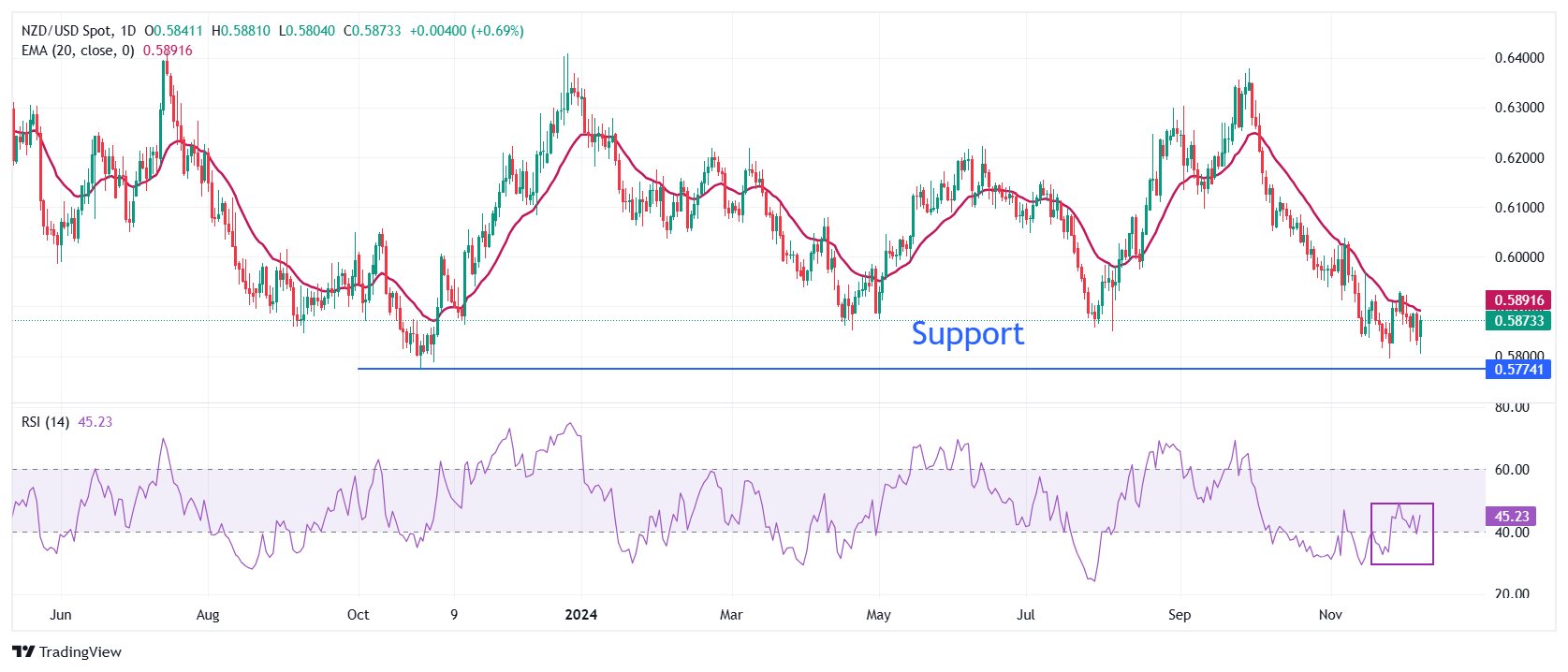NZD/USD Price Forecast: Bounces back strongly to near 0.5870
- NZD/USD recovers sharply to near 0.5870 as China’s Politburo supported expansionary monetary and fiscal policies.
- The RBNZ is expected to cut interest rates again by 50 bps.
- Investors await the US CPI data for fresh interest rate guidance.
The NZD/USD pair rebounds strongly to near 0.5870 in the North American trading session on Monday after testing the annual low of 0.5800. The Kiwi pair jumps higher as the New Zealand Dollar (NZD) strengthens after China’s Politburo vowed to implement “more proactive fiscal policy and moderately loose monetary policy.” A scenario that will boost stimulus and allow the economy to achieve its economic targets.
It is worth noting that New Zealand is one of the leading trading partners of China and a boost to economic stimulus is favorable for the New Zealand Dollar.
Domestically, the outlook of the NZD remains weak as the Reserve Bank of New Zealand (RBNZ) is expected to continue with its aggressive policy-easing stance. The RBNZ reduced its Official Cash Rate (OCR) by 50 basis points (bps) to 4.25% in its monetary policy meeting on November 27 and guided for a similar rate cut pace if economic conditions continue to evolve as projected.
Meanwhile, the US Dollar (USD) consolidates, with investors focusing on the United States (US) Consumer Price Index (CPI) data for November, which will be released on Wednesday.
NZD/USD finds temporary support near 0.5800, while the 20-day Exponential Moving Average (EMA) near 0.5930 continues to act as a major barricade for the NZD bulls. The 14-day Relative Strength Index (RSI) rebounded after conditions turned oversold and climbed above 40.00, suggesting that the bearish momentum has faded. However, the bearish trend has not extinguished.
The Kiwi pair is expected to decline to near the October 2023 low at 0.5770 and the round-level support of 0.5700 if it retreats below 0.5820.
On the contrary, an upside move above the November 15 high of 0.5970 will drive the asset toward the psychological figure of 0.6000 and the November 7 high of 0.6040.
NZD/USD daily chart
New Zealand Dollar FAQs
The New Zealand Dollar (NZD), also known as the Kiwi, is a well-known traded currency among investors. Its value is broadly determined by the health of the New Zealand economy and the country’s central bank policy. Still, there are some unique particularities that also can make NZD move. The performance of the Chinese economy tends to move the Kiwi because China is New Zealand’s biggest trading partner. Bad news for the Chinese economy likely means less New Zealand exports to the country, hitting the economy and thus its currency. Another factor moving NZD is dairy prices as the dairy industry is New Zealand’s main export. High dairy prices boost export income, contributing positively to the economy and thus to the NZD.
The Reserve Bank of New Zealand (RBNZ) aims to achieve and maintain an inflation rate between 1% and 3% over the medium term, with a focus to keep it near the 2% mid-point. To this end, the bank sets an appropriate level of interest rates. When inflation is too high, the RBNZ will increase interest rates to cool the economy, but the move will also make bond yields higher, increasing investors’ appeal to invest in the country and thus boosting NZD. On the contrary, lower interest rates tend to weaken NZD. The so-called rate differential, or how rates in New Zealand are or are expected to be compared to the ones set by the US Federal Reserve, can also play a key role in moving the NZD/USD pair.
Macroeconomic data releases in New Zealand are key to assess the state of the economy and can impact the New Zealand Dollar’s (NZD) valuation. A strong economy, based on high economic growth, low unemployment and high confidence is good for NZD. High economic growth attracts foreign investment and may encourage the Reserve Bank of New Zealand to increase interest rates, if this economic strength comes together with elevated inflation. Conversely, if economic data is weak, NZD is likely to depreciate.
The New Zealand Dollar (NZD) tends to strengthen during risk-on periods, or when investors perceive that broader market risks are low and are optimistic about growth. This tends to lead to a more favorable outlook for commodities and so-called ‘commodity currencies’ such as the Kiwi. Conversely, NZD tends to weaken at times of market turbulence or economic uncertainty as investors tend to sell higher-risk assets and flee to the more-stable safe havens.

